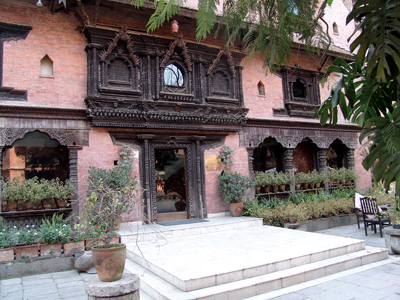DWARIKA’S HOTEL
“Dwarika’s is not a Hotel – it is a philosophy of life. Superb heritage with excellent team work and service”. One of the hundreds of compliments received by Dwarika’s who have for the last fifty years, been in the forefront when it comes to preserving Nepal’s cultural heritage. It was the Late Dwarika Das Shrestha, who envisioned this massive project after witnessing the destruction of valuable pieces of art. His collection, started during the 1950s is now being expanded by his wife, Ambica Shrestha and daughter, Sangita Shrestha Einhaus. Dwarika’s is a treasure house of ethnic brick and wooden structures which showcase our true architectural heritage and excellent craftsmanship of a people dedicated to their art.
 Dwarika’s captures the imagination of anyone who cares for conservation. From the moment you enter the hotel, you are transported to a world belonging to another era. The exquisite wood-carved windows, doors, pillars, toranas and decorations are our cultural heritage, as they have been salvaged from old existing buildings. Some have been restored. But even the new creations speak of the superb skill of the craftsmen, comparable to the antiques
Dwarika’s captures the imagination of anyone who cares for conservation. From the moment you enter the hotel, you are transported to a world belonging to another era. The exquisite wood-carved windows, doors, pillars, toranas and decorations are our cultural heritage, as they have been salvaged from old existing buildings. Some have been restored. But even the new creations speak of the superb skill of the craftsmen, comparable to the antiques
that fill this hotel. The rooms showcase Nepali traditions, and the decorations are unmistakably Newari.
Hotel shanker
The palace which once belonged to Mr. AGM. Sh. J. B. Rana was to be converted to a hotel. This palace was about 85 years old at the time of conversion. The palace was a major landmark of Kathmandu and needed to be preserved in the original design. The functional aspects had to be governed by the cultural and aesthetics of the original architecture.
We retained the exterior envelope as original (with very slight modifications which is not visible to the ordinary eye). However as far as the interior is concerned, the Banquet Hall was maintained in the original form. The general atmosphere was modified to the extent that it retains the original flavor yet they are different. But the public areas such as lobbies and corridors were designed in keeping with Nepalese interiors. The bar at the ground floor was decorated with old Nepalese carving from Mr. Ram Shanker’s collection. The dining hall at the sub basement was decorated in the style of Nepalese interiors with paintings and murals.
The main emphasis was on retaining the landmark and developing the hotel as a modern palace where Europe meets Nepal.
-Shankar N. Rimal, (engineer).
HOTEL YAK & YETI
Hotel Yak & Yeti, Kathmandu’s historical wonder, one of Nepal’s finest hotels; a statement that is no exaggeration as the hotel maintains the monumental Lal Durbar belonging to the Rana period, which blends remarkably well with the contemporary building. Our cultural heritage that reminds one of the splendour of old Rana palaces is well preserved. Time has been entrapped within the walls of the hotel giving us a glimpse of an era long gone.
Extensive renovation has kept the historical facets intact, which are perceived in the various halls like the ‘Regal Room’, the ‘Durbar Hall’, the ‘Dynasty Hall’ and ‘Regency Hall’. The intricate designs that accentuate the beauty of these halls remain unblemished. The decorative art such as the strikingly beautiful ceilings, vibrant wall-decorations, sparkling chandeliers, old-fashioned imported mirrors and priceless paintings highlight the antiquity of this place. Elaborate wood carvings depict true Nepali woodcraft within the confines of the fabulous ‘Durbar Hall’. Another tastefully preserved hall is the ‘Naachghar’, which as the name suggests serves as the entertainment facility and is in fact, the original palace theatre restored. These well preserved halls showcase the taste of the Rana rulers, who spent vast amounts of their wealth in building palaces that emulate the grandeur of European architecture.
HYATT REGENCY
This monumental building set on a 37- acre property, may well be regarded as the largest hotel showcasing the heritage of Nepal through its inspiring architectural design that reflects the traditional temple architecture prevalent in the valley. Enhancing the beauty of the building are the windows that portray typical Newari art.
Remarkably attractive is the Temple Court, which encloses nine important Chaityas, which were constructed under the supervision of Niels Gutschow, a reputed conservation architect, researcher and writer. As you enter the main building, there is a stone path with water spouts below the fabulous Golden Gate which truly represent Nepal’s cultural heritage.
Asked about the hotel’s adoption of local culture & heritage, the General Manager, Ms. Harinder Singh, says, “Nepal as a destination is rich in its wealth of culture and national heritage and it is one of the many reasons why tours, travel and incentive programs opt for Nepal. There is an enormous amount of untapped resources, which has potential for growth. At Hyatt International we believe in highlighting this aspect in our hotel – be it the traditionally Newari architecture of our buildings, the courtyard like design of our Temple Court which has replicas of Chaityas found in Nepal between the 11th to 18th centuries, our water court, or the wood carving around the hotel – all with the exclusive service standards of Hyatt International.”
Reinhold Messner
“Traditional mountaineering is the art of not dying.” Reinhold Messner is one of the most well known...








